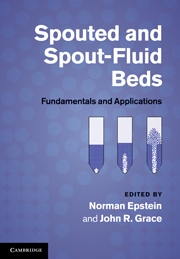Book contents
- Frontmatter
- Contents
- Contributors
- Preface
- Common nomenclature
- 1 Introduction
- 2 Initiation of spouting
- 3 Empirical and analytical hydrodynamics
- 4 Computational fluid dynamic modeling of spouted beds
- 5 Conical spouted beds
- 6 Hydrodynamics of spout-fluid beds
- 7 Spouted and spout-fluid beds with draft tubes
- 8 Particle mixing and segregation
- 9 Heat and mass transfer
- 10 Powder–particle spouted beds
- 11 Drying of particulate solids
- 12 Drying of solutions, slurries, and pastes
- 13 Granulation and particle coating
- 14 The Wurster coater
- 15 Gasification, pyrolysis, and combustion
- 16 Spouted bed electrochemical reactors
- 17 Scaleup, slot-rectangular, and multiple spouting
- 18 Mechanical spouting
- 19 Catalytic reactors and their modeling
- 20 Liquid and liquid–gas spouting of solids
- Index
- References
18 - Mechanical spouting
Published online by Cambridge University Press: 04 February 2011
- Frontmatter
- Contents
- Contributors
- Preface
- Common nomenclature
- 1 Introduction
- 2 Initiation of spouting
- 3 Empirical and analytical hydrodynamics
- 4 Computational fluid dynamic modeling of spouted beds
- 5 Conical spouted beds
- 6 Hydrodynamics of spout-fluid beds
- 7 Spouted and spout-fluid beds with draft tubes
- 8 Particle mixing and segregation
- 9 Heat and mass transfer
- 10 Powder–particle spouted beds
- 11 Drying of particulate solids
- 12 Drying of solutions, slurries, and pastes
- 13 Granulation and particle coating
- 14 The Wurster coater
- 15 Gasification, pyrolysis, and combustion
- 16 Spouted bed electrochemical reactors
- 17 Scaleup, slot-rectangular, and multiple spouting
- 18 Mechanical spouting
- 19 Catalytic reactors and their modeling
- 20 Liquid and liquid–gas spouting of solids
- Index
- References
Summary
Principle of mechanical spouting
One of the main advantages of the conventional spouted bed is the characteristic recirculation particle mixing provided by a high-velocity gas jet through a nozzle at the conical bottom of the equipment. This ensures very effective “quasi-countercurrent” gas–solid contact. Because of the circulation of the particles, local overheating within the bed can be avoided and thus uniform product quality can be effected.
Disadvantages include fluid motive-power consumption that occurs especially at the start of operation, but also persists under stable conditions owing to the vertical particle transport in the spout and the high pressure drop of the nozzle. In addition, conditions for heat and mass transfer can be obtained only within a limited range of gas flowrate because the velocity of the gas, usually air, is determined mainly by the size and density of the particles.
These disadvantages of the spouted bed can be eliminated, while keeping its advantages, by the mechanically spouted bed (MSB), in which the most important characteristics of conventional spouted beds can be found. According to the developed prototype, the typical spouted circulating motion is ensured by an open conveyor screw, installed along the vertical axis of the device, independent of the airflow rate. The diameter of the screw is nearly equal to the diameter of the gas channel (spout), around which a similar dense sliding layer (annulus) is formed.
- Type
- Chapter
- Information
- Spouted and Spout-Fluid BedsFundamentals and Applications, pp. 297 - 304Publisher: Cambridge University PressPrint publication year: 2010



